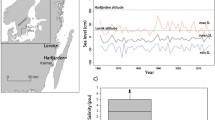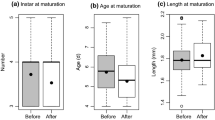Abstract
While natural selection might in some cases facilitate invasions into novel habitats, few direct measurements of selection response exist for invasive populations. This study examined selection response to changes in salinity using the copepod Eurytemora affinis. This copepod has invaded fresh water from saline habitats multiple times independently throughout the Northern Hemisphere. Selection response to a constant intermediate salinity (5 PSU) was measured in the laboratory for saline source and freshwater invading populations from the St. Lawrence drainage (North America). These populations were reared under three conditions: (1) native salinities (0 or 15 PSU) for at least two generations, (2) 5 PSU for two generations, and (3) 5 PSU for six generations. Full-sib clutches taken from populations reared under these three conditions were split across four salinities (0, 5, 15, and 25 PSU) to determine reaction norms for survival and development time. Contrasts in survival and development time across the three rearing conditions were treated as the selection response. Selection at 5 PSU resulted in a significant decline in freshwater (0 PSU) tolerance for both the saline and freshwater populations. Yet, evolutionary differences in freshwater tolerance persisted between the saline and freshwater populations. The saline and freshwater populations converged in their high-salinity (25 PSU) tolerance, with an increase in the freshwater population and decline in the saline population. Development time did not shift greatly in response to selection at 5 PSU. For all three rearing conditions, the freshwater population exhibited retarded larval development and accelerated juvenile development relative to the saline population. Results from this study indicate that both the saline and freshwater populations exhibit significant responses to selection for a fitness-related trait critical for invasions into a novel habitat.






Similar content being viewed by others
References
Agrawal AF, Brodie ED, Rieseberg LH (2001) Possible consequences of genes of major effect: transient changes in the G-matrix. Genetica 112:33–43
Albert JH, Chib S (2001) Sequential ordinal modeling with applications to survival data. Biometrics 57:829–836
Barrera R, Medialdea V (1996) Development time and resistance to starvation of mosquito larvae. J Nat History 30:447–458
Billingsley P (1986) Probability and measure (2nd edn). John Wiley and Sons, New York
Blair AC, Wolfe LM (2004) The evolution of an invasive plant: an experimental study with Silene latifolia. Ecology 85:3035–3042
Bossdorf O, Auge H, Lafuma L, Rogers WE, Siemann E, Prati D (2005) Phenotypic and genetic differentiation between native and introduced plant populations. Oecologia 144:1–11
Carroll SP, Dingle H, Famula TR, Fox CW (2001) Genetic architecture of adaptive differentiation in evolving host races of the soapberry bug, Jadera haematoloma. Genetica 112:257–272
Chippindale AK, Gibbs AG, Sheik M, Yee KJ, Djawdan M, Bradley TJ, Rose MR (1998) Resource acquisition and the evolution of stress resistance in Drosophila melanogaster. Evolution 52:1342–1352
Colwell RR (2004) Perspectives: infectious disease and environment: cholera as a paradigm for waterborne disease. Int Microbiol 7:285–289
Crow JF, Kimura M (1970) An introduction to population genetics theory. Harper and Row, Publishers, New York
Curtsinger JW, Service PM, Prout T (1994) Antagonistic pleiotropy, reversal of dominance, and genetic-polymorphism. Am Nat 144:210–228
Donohue K, Dorn L, Griffith C, Kim E, Aguiler A, Polisetty CR, Schmitt J (2005a) The evolutionary ecology of seed germination of Arabidopsis thaliana: variable natural selection on germination timing. Evolution 59:740–757
Donohue K, Dorn L, Griffith C, Kim E, Aguilera A, Polisetty CR, Schmitt J (2005b) The evolutionary ecology of seed germination of Arabidopsis thaliana: variable natural selection on germination timing. Evolution 59:758–770
Dunstan GA, Brown MR, Volkman JK (2005) Cryptophyceae and rhodophyceae; chemotaxonomy, phylogeny, and application. Phytochemistry 66:2557–2570
Ebert D (1995) The ecological interactions between a microsporidian parasite and its host Daphnia magna. J Anim Ecol 64:361–369
Engel RA (1962) Eurytemora affinis, a calanoid copepod new to Lake Erie. Ohio J Sci 62:252
Faber DJ, Jermolajev EG, Kossiakina EG (1966) A new copepod genus in the plankton of the Great Lakes. Limnol Oceanogr 11:301–303
Falconer DS, Mackay TFC (1996) Introduction to quantitative genetics. Prentice Hall, New York, NY
Gibbs AG (2002) Water balance in desert Drosophila: lessons from non-charismatic microfauna. Comp Biochem Physiol A-Mol Integ Physiol 133:781–789
Hairston NG, Dillon TA (1990) Fluctuating selection and response in a population of fresh-water copepods. Evolution 44:1796–1805
Harshman LG, Hoffmann AA, Clark AG (1999) Selection for starvation resistance in Drosophila melanogaster: physiological correlates, enzyme activities and multiple stress responses. J Evol Biol 12:370–379
Huey RB, Gilchrist GW, Carlson ML, Berrigan D, Serra L (2000) Rapid evolution of a geographic cline in size in an introduced fly. Science 287:308–309
Khlebovich VV, Abramova EN (2000) Some problems of crustacean taxonomy related to the phenomenon of Horohalinicum. Hydrobiologia 417:109–113
Lande R, Arnold SJ (1983) The measurement of selection on correlated characters. Evolution 37:1210–1226
Lee CE (1999) Rapid and repeated invasions of fresh water by the saltwater copepod Eurytemora affinis. Evolution 53:1423–1434
Lee CE (2000) Global phylogeography of a cryptic copepod species complex and reproductive isolation between genetically proximate “populations”. Evolution 54:2014–2027
Lee CE (2002) Evolutionary genetics of invasive species. Trends Ecol Evol 17:386–391
Lee CE, Bell MA (1999) Causes and consequences of recent freshwater invasions by saltwater animals. Trends Ecol Evol 14:284–288
Lee CE, Frost BW (2002) Morphological stasis in the Eurytemora affinis species complex (Copepoda: Temoridae). Hydrobiologia 480:111–128
Lee CE, Petersen CH (2003) Effects of developmental acclimation on adult salinity tolerance in the freshwater-invading copepod Eurytemora affinis. Physiol Biochem Zool 76:296–301
Lee CE, Petersen CH (2002) Genotype-by-environment interaction for salinity tolerance in the freshwater invading copepod Eurytemora affinis. Physiol Biochem Zool 75:335–344
Lee CE, Remfert JL, Gelembiuk GW (2003) Evolution of physiological tolerance and performance during freshwater invasions. Integr Comp Biol 43:439–449
Parker IM, Rodriguez J, Loik ME (2003) An evolutionary approach to understanding the biology of invasions: local adaptation and general-purpose genotypes in the weed Verbascum thapsus. Conserv Biol 17:59–72
Peterson WT (2001) Patterns in stage duration and development among marine and freshwater calanoid and cyclopoid copepods: a review of rules, physiological constraints, and evolutionary significance. Hydrobiologia 453–454:91–105
Piasecki W, Goodwin AE, Eiras JC, Nowak BF (2004) Importance of copepoda in freshwater aquaculture. Zool Stud 43:193–205
Reznick DN, Ghalambor CK (2001) The population ecology of contemporary adaptations: what empirical studies reveal about the conditions that promote adaptive evolution. Genetica 112:183–198
Ricciardi A, MacIsaac HJ (2000) Recent mass invasion of the North American Great Lakes by Ponto-Caspian species. Trends Ecol Evol 15:62–65
Santos M, Cespedes W, Balanya J, Trotta V, Calboli FCF, Fontdevila A, Serra L (2005) Temperature-related genetic changes in laboratory populations of Drosophila subobscura: evidence against simple climatic-based explanations for latitudinal clines. Am Nat 165:258–273
SAS (2003) Version 9.1. SAS Institute Inc., Cary, NC
Schemske DW, Bierzychudek P (2001) Perspective: evolution of flower color in the desert annual Linanthus parryae: Wright revisited. Evolution 55:1269–1282
Stirnadel HA, Ebert D (1997) Prevalence, host specificity and impact on host fecundity of microparasites and epibionts in three sympatric Daphnia species. J Anim Ecol 66:212–222
Turelli M, Barton NH (2004) Polygenic variation maintained by balancing selection: pleiotropy, sex-dependent allelic effects and GxE interactions. Genetics 166:1053–1079
Vanderploeg HA, Liebig JR, Gluck AA (1996) Evaluation of different phytoplankton for supporting development of zebra mussel larvae (Dreissena polymorpha): the importance of size and polyunsaturated fatty acid content. J Great Lakes Res 22:36–45
Weinig C (2000a) Plasticity versus canalization: population differences in the timing of shade-avoidance responses. Evolution 54:441–451
Weinig C (2000b) Limits to adaptive plasticity: temperature and photoperiod influence shade-avoidance responses. Am J Bot 87:1660–1668
Weinig C, Delph LF (2001) Phenotypic plasticity early in life constrains developmental responses later. Evolution 55:930–936
Williamson M, Fitter A (1996) The varying success of invaders. Ecology 77:1661–1666
Wills C (1975) Marginal overdominance in Drosophila. Genetics 81:177–189
Acknowledgements
The paper constitutes a portion of the material presented for the symposium entitled, “All Stressed Out and Nowhere to Go: Does Evolvability Limit Adaptation in Invasive Species?” at the 2004 SSE/SSB/ASN conference in Fort Collins, CO, organized by Carol Lee and George Gilchrist. Funding for this study was provided by NSF DEB-0130543 to C. E. Lee. Stephane Plourde, Marc Ringuette, and Gesche Winkler collected saline samples from the Baie de L’Isle Verte in Quebec, Canada. Heather Free, Meghan Olson, Dan Skelly, and Greg Gelembiuk collected freshwater samples from Racine Harbor, Lake Michigan, Wisconsin and helped maintain the copepod and algal cultures. Greg Gelembiuk made useful suggestions on the statistical analyses. Lee Lab members provided editorial comments. Two reviewers provided useful suggestions on organization and structure of the paper.
Author information
Authors and Affiliations
Corresponding author
Additional information
For the Symposium on “Evolvability and Adaptation of Invasive Species,” Society for the Study of Evolution 2004.
Rights and permissions
About this article
Cite this article
Lee, C.E., Remfert, J.L. & Chang, YM. Response to selection and evolvability of invasive populations. Genetica 129, 179–192 (2007). https://doi.org/10.1007/s10709-006-9013-9
Received:
Accepted:
Published:
Issue Date:
DOI: https://doi.org/10.1007/s10709-006-9013-9




